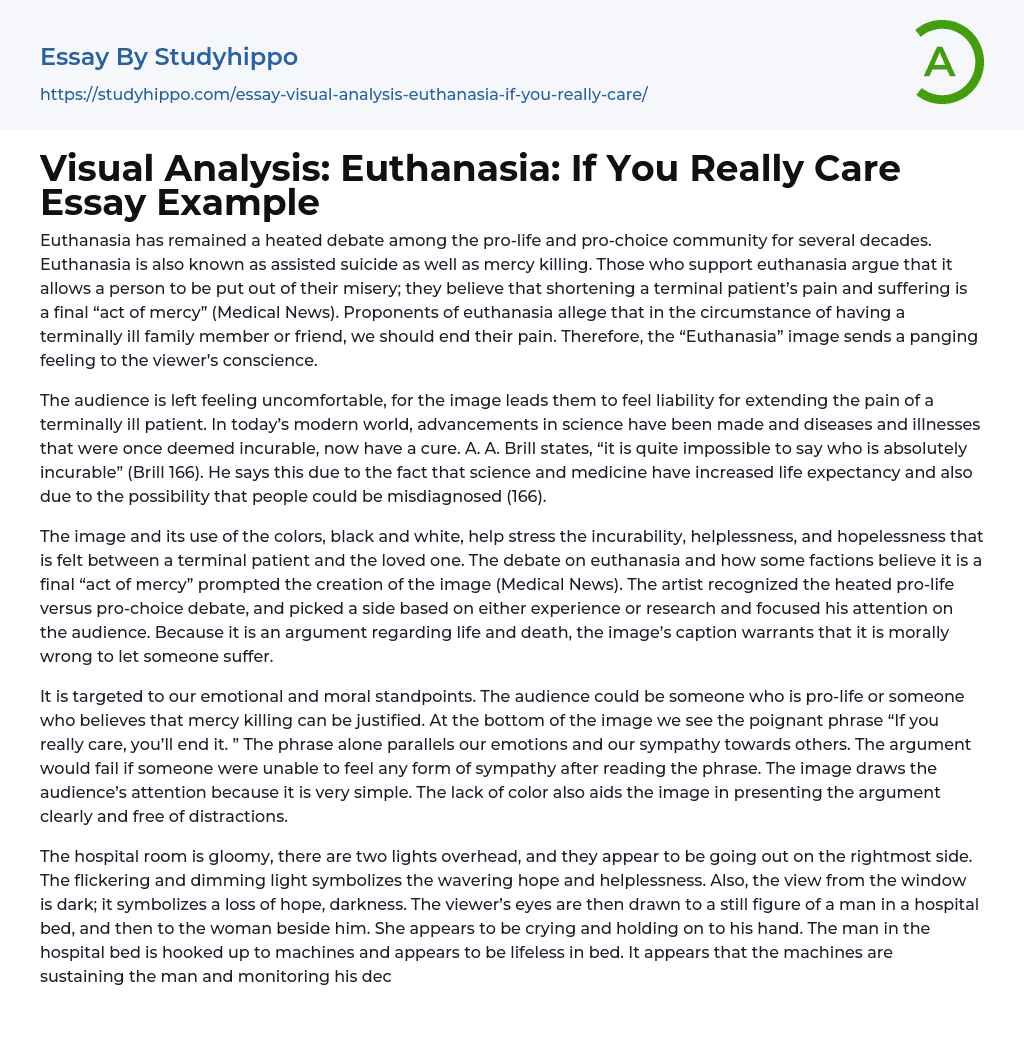

Visual Analysis: Euthanasia: If You Really Care Essay Example
Euthanasia, also referred to as assisted suicide or mercy killing, is a highly debated issue among advocates and critics alike. Supporters argue that it offers relief from suffering and represents a compassionate approach towards individuals with terminal illnesses. They maintain that in cases where a loved one is experiencing incurable pain, ending their suffering is morally justifiable. Consequently, discussions surrounding euthanasia elicit intense emotions and stimulate ethical reflection.
The image evokes discomfort among viewers as it implies their involvement in the continuing agony of a patient with an incurable illness. In our modern world, scientific progress has enabled the treatment of diseases and ailments previously deemed untreatable. A. A. Brill notes that accurately classifying individuals as incurable is challenging due to extended lifespans and the potential for misdiagnosis
...(Brill 166).
The image depicts the uncurable nature, helplessness, and hopelessness that exists between a terminally ill patient and their loved one. The use of black and white colors is utilized to emphasize these emotions. This artwork was created in response to the ongoing euthanasia debate, with some viewing it as a compassionate final act. The artist took a strong stance based on personal experience or research and directly targeted the audience with their message. Since the argument concerns matters of life and death, the accompanying caption firmly states that allowing someone to suffer is morally wrong (Medical News).
The image appeals to emotional and moral perspectives, targeting both supporters of the pro-life movement and those who believe in justified mercy killing. At the bottom of the image, a powerful phrase "If you really care, you'll end it" evokes empathy and connection.
The argument's effectiveness relies on the audience's ability to feel sympathy upon reading the phrase. The simplicity of the image, combined with its absence of color, helps to present the argument clearly without any distractions.
The hospital room is poorly illuminated, with two overhead lights that are becoming less bright on the right side. This flickering and dimming light symbolizes the uncertain hope and powerlessness experienced in the room. The scene outside the window is also gloomy, representing a loss of hope and darkness. The attention then turns to an immobile man lying in a hospital bed, accompanied by a woman. She can be observed crying while holding his hand. The man is attached to machines that are sustaining his life and monitoring his deteriorating health.
Upon close observation, it becomes evident that the man's vital signs rise before eventually flatlining. Positioned in front of him is a plant, serving as a striking contrast to his worsening physical state. Despite the woman hiding her face while bowing over the man, the artist believes that viewers will sense her tears and anguish. Failing to make this inference would lead to overlooking the underlying message.
The image may seem unclear to many because the audience cannot directly sense emotions from it. However, the audience would need prior knowledge about euthanasia and the ability to make an inference in order to fully understand the message. The artist of the political cartoon aims to elicit a response from the viewers. Depending on the constraint that the audience should feel a moral duty, the author carefully selects his words and uses a font that reflects the intended
emotion. The word choice in the image is powerful.
At the bottom, the statement “If you really care, you’ll end it. ” Again, the words evoke a sense of moral responsibility, aiming to unsettle the viewer. The artist chose a font that enhances the emotional impact, using a blocky style that delivers a fast and powerful message, almost urging the reader. By scrutinizing the political cartoon's attributes, the viewer gains a deeper comprehension of the matter at hand. Though the image played a significant role in conveying the argument, it was the deliberate selection of words that had the most profound effect.
The image evokes a strong emotional response from viewers and tugs at their heart and conscience. It challenges them to imagine themselves in a hypothetical situation and states, "If you really care, you'll end it" (Euthanasia). The image, portrayed as a black and white cartoon with bold block lettering, effectively conveys the creator's message that euthanasia is an act of mercy for terminally ill individuals. This argument is clear and comprehensible.
- Values of Life essays
- Ethical dilemma essays
- Normative Ethics essays
- Virtue Ethics essays
- Belief essays
- Deontology essays
- Moral essays
- Virtue essays
- Work Ethic essays
- Affirmative Action essays
- Assisted Suicide essays
- Capital Punishment essays
- Censorship essays
- Child Labour essays
- Child Protection essays
- Civil Rights essays
- Corporal Punishment essays
- Death Penalty essays
- Empowerment essays
- Euthanasia essays
- Gay Marriage essays
- Gun Control essays
- Human Trafficking essays
- Police Brutality essays
- Privacy essays
- Sex Trafficking essays
- Speech essays
- Acceptance essays
- Age Of Enlightenment essays
- Child Observation essays
- Confucianism essays
- Conscience essays
- Critical Reflection essays
- Destiny essays
- Determinism essays
- Empiricism essays
- Environmentalism essays
- Epistemology essays
- Ethics essays
- Ethos essays
- Existence essays
- Existentialism essays
- Fate essays
- Free Will essays
- Functionalism essays
- Future essays
- Good And Evil essays
- Human Nature essays
- Individualism essays
- Meaning Of Life essays



